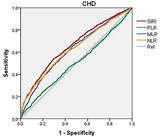Analysis of the correlation between the Systemic Inflammatory Response Index and the severity of coronary vasculopathy
DOI:
https://doi.org/10.17305/bb.2024.10747Keywords:
Systemic inflammatory response index, coronary heart disease, Gensini score, severity of coronary artery diseaseAbstract
This study aims to analyze the correlation between Systemic Inflammatory Response Index (SIRI) and the severity of coronary artery stenosis in patients with coronary heart disease (CHD). It also aims to assess the predictive value of SIRI for the severity of coronary artery stenosis. A total of 2990 patients who underwent coronary angiography were included in this study. The Gensini score was used to estimate the severity of coronary vascular lesions. The predictive ability of SIRI for CHD was evaluated using receiver operating characteristic (ROC) curves. Binary multivariate logistic regression analysis was used to predict the likelihood of CHD based on the SIRI index. The results showed that people with higher SIRI were more likely to have CHD (P < 0.001). After controlling for other risk factors, the highest quartile had a significantly higher incidence of coronary artery disease compared to the lowest quartile (odds ratio [OR] 2.25, 95% confidence interval [CI] 1.73-3.92, P < 0.001). Furthermore, the Gensini score was significantly higher in the fourth quartile group (T4) compared to the first (T1) and second (T2) quartile groups (P < 0.001). Additionally, the SIRI was significantly higher in the group with severe coronary artery lesions compared to the mild and moderate groups (P < 0.001). The SIRI also showed a higher predictive ability for the extent of coronary lesions under the ROC curve compared to other commonly used markers, including platelet-to-lymphocyte ratio (PLR), monocyte-to-lymphocyte ratio (MLR), and neutrophil-to-lymphocyte ratio (NLR) (P < 0.001). Therefore, SIRI positively correlates with coronary artery stenosis in CHD patients, serving as an effective early screening marker for assessing stenosis severity.
Citations
Downloads

Downloads
Published
Issue
Section
Categories
License
Copyright (c) 2024 Ting He, Yinhua Luo, Jingjing Wan, Ling Hou, Ke Su, Jinbo Zhao, Yuanhong Li

This work is licensed under a Creative Commons Attribution 4.0 International License.









